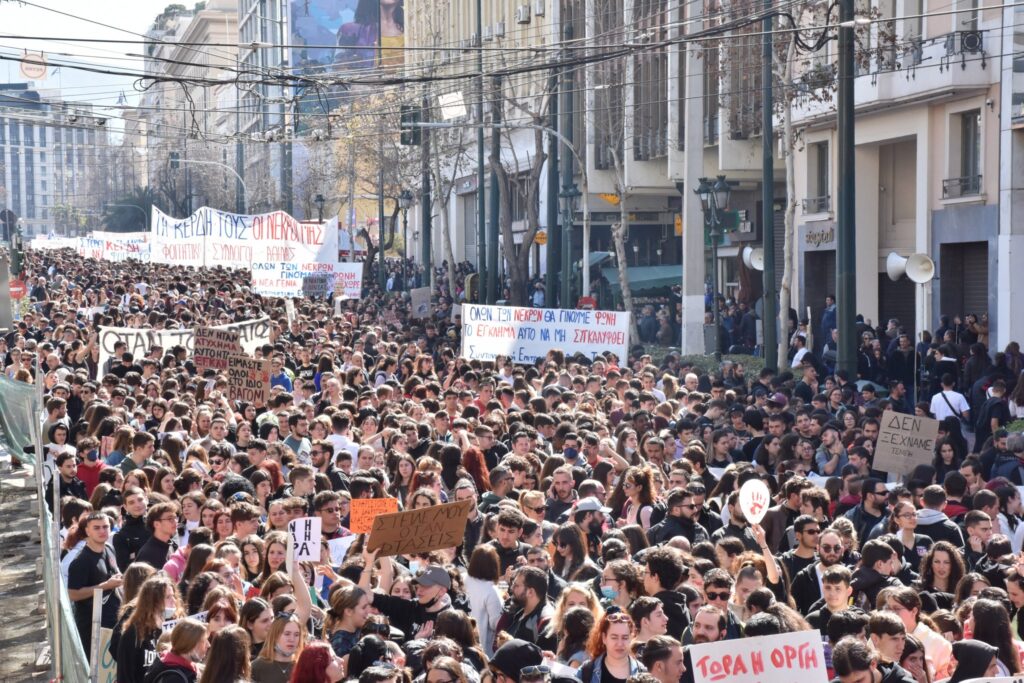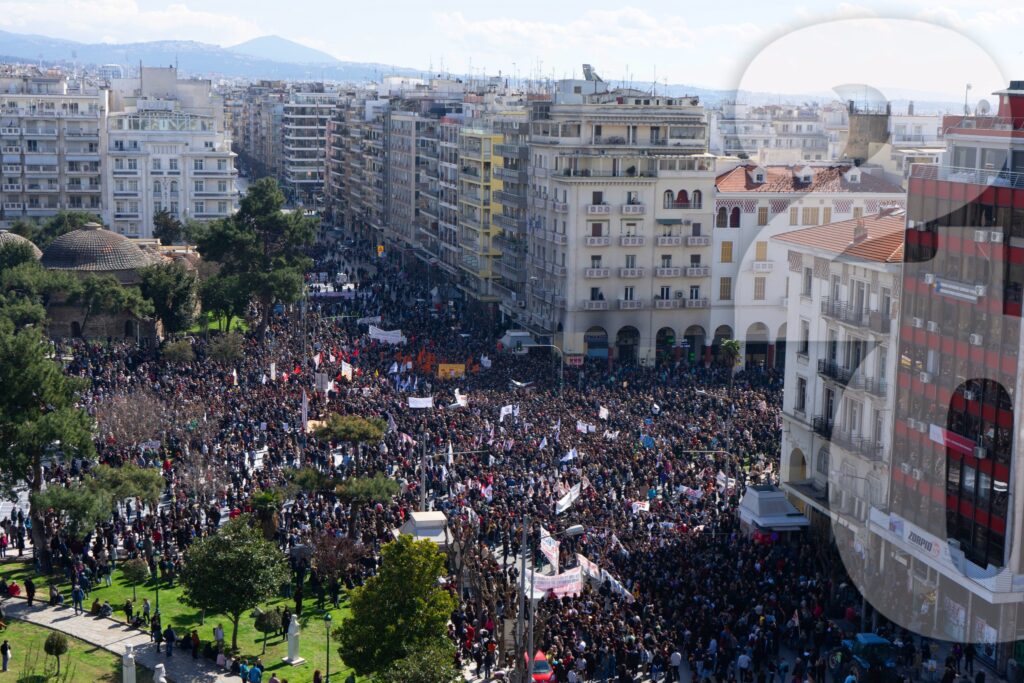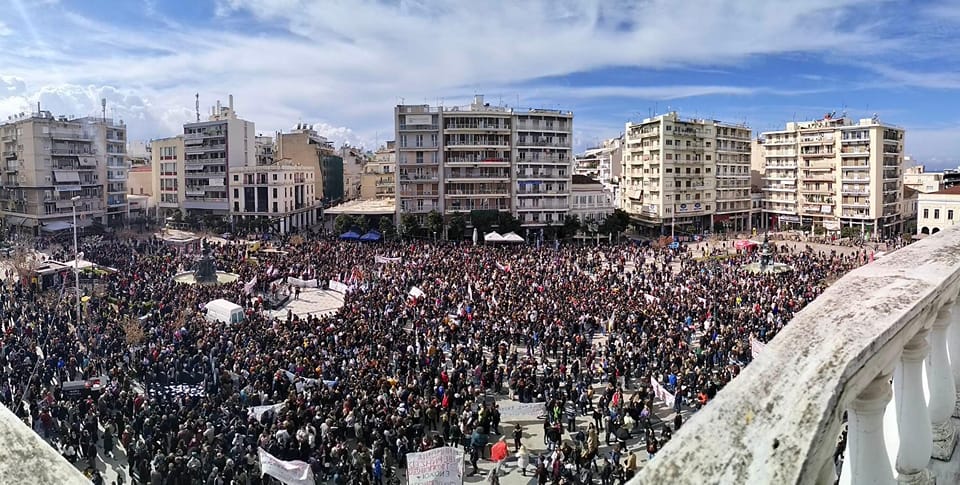Nikos Anastasiadis
The Tempihead-on train crash on February 28 with about 60 dead and a similar number missing and with many still in hospital, sparked a chain of events that has led to the biggest (near) general strike in recent years in Greece and huge demonstrations. The mobilisations were reminiscent of 2010-2013, the years of mass resistance to austerity and the Troika.

A historic day
It is very difficult to have an exact estimate of how many people took part in the demonstrations on March 8. To give context to our readers, in a number of big cities two demos were called during the day: in the morning, strike demos were called, and in the afternoon, the International Women’s Day demos also took an anti-government character.
Φωτογραφίες από την απογευματινή πορεία στις 8 Μαρτίου. #8march #protest #trainose
Δημοσιεύτηκε από Δημήτρης Μητράκας στις Τετάρτη, 8 Μαρτίου 2023
The official trade union confederation (GSEE) refused to call a general strike, despite the mood pushing in that direction from below. But this obstacle was not enough to stop people coming out on the streets.
In fact, ADEDY, the confederation of public servant unions called a 24-hour strike. This call was echoed by a number of Union Federations and by local Workers’ Centers (an official trade union structure which brings together all the unions public and private on a city basis) in all the major cities including Athens and Thessaloniki. Some of the biggest federations such as healthcare workers and teachers also joined the strike. What happened in practice was that an (almost) general strike was imposed by the pressure from below.
In Athens, in the morning demo, 100,000 people took part. It was the biggest mobilisation since the “NO” (ΟΧΙ) demo in 2015, and can only be compared to the huge anti-austerity demonstrations during the first years of the debt crisis. The evening demo was significantly bigger than the normal March 8 demonstrations of previous years . Feminist demands were combined with recent events, giving the mobilisation a “dual” character.

In Thessaloniki, reports calculate that 30,000 people took to the streets in the morning, and quite a few thousand in the evening..
But this was not a movement of only the big cities. Demos were called in 73 cities, a profound number even for Greek standards. Even remote islands were involved in the mobilisations, r. In Athens and Thessaloniki, demonstrations have been held almost daily since March 1.
As most of the people who died in the train crash were university students, the movement in response has been particularly strong on university campuses with over 100 university schools/departments currently under occupation. There are also the first signs of high school students taking action. On Friday, 3,000 took part in a school student march in Piraeus, while on Wednesday whole schools were coming out joining the demos.
It’s also interesting to note that a number of anti-government banners appeared in football stadiums on Sunday, something that only happens rarely, and is a clear sign of the mood in society.

Mood
This movement definitely represents a change of mood inside Greek society. While a feeling of grief is definitely evident, anger is boiling. The train crash has led to the realisation among wide layers that people on the InterCity 62 train travelling on February 28th died only because austerity and profits matter more than human lives. That served as the last straw for many people, who have suffered through inhumane austerity policies during the debt crisis, mass unemployment, the criminal management of the pandemic, police repression and so on. A hugelayer of people are fed up with this corrupt and reactionary government and want to see it gone as soon as possible.
The handling of this crisis by the media and the state is also adding fuel to the fire. Initially they were trying to present the Station Master as solely responsible for the accident, deliberately trying to hide their own culpabilties. They are so out of touch with society that they are making one mistake after another, enraging people even more.
Some of the slogans prevailing in the demos included:
“It was not a ‘bad moment’, the government and capital killed the passengers”
“Transport, energy and water are not commodities, they belong to the people”
“‘Send a message when you arrive’, they never did, we will take revenge for you kid”
“This crime will not be covered-up, we will become the voice of the dead”
“You are talking about profits and losses, we are talking about human lives”
“NEW DEMOCRACY-PASOK-SYRIZA, this crime has a history”.
Need for escalation
One important and unusual aspect of the recent demonstrations was that they were largely unified. The Greek Left has a very sectarian tradition of holding different demos during every strike, sometimes with more than 5 competing demos in one day!
This time, because of the huge crowds the Left was essentially forced to take part in one unified demo, although the rallies started at different meeting places. This has helped the dynamic of the movement.
This movement has already cornered the government and has the capacity, objectively, to even bring it down. Elections should be held by -July at the latest, when the 4 year term of the present government ends. Before the accident, the government was planning to hold them in April.Now, they have postponed the announcement out of fear for the outcome.
Xekinima is heavily intervening in the events taking place, in all major demonstrations in the cities where we have presence, in some cases calling the demonstrations ourselves, as for example in Volos and Lesbos.
Η σημερινή απεργιακή συγκέντρωση στο Βόλο ήταν μια από τις μεγαλύτερες κινητοποιήσεις εδώ και πολλά χρόνια. Μπορεί να…
Δημοσιεύτηκε από Ξεκίνημα Βόλου στις Τετάρτη, 8 Μαρτίου 2023
Our central demands are the folllowing:
- For an independent inquiry into the train crash with the decisive participation of the train workers and with participation of international train workers’ unions.
- For the renationalization of the Railways under workers’ control and management, as the only way to have safe trains, qualitative transport and low cost fares.
- For an immediate stoppage of all trains, i.e. an indefinite rail strike, demanding safety regulations to be implemented and the renationalization of the railroads.
- For an immediate 24 hour general strike with the renationalization of the railroads as its central demand, which should be repeated on a weekly basis until the government backs down.
- For immediate occupations in schools and colleges across the country.
- All struggles to be coordinated by action committees, democratically ran, in workplaces, schools, colleges and neighbourhoods, coordinated on a national level.












